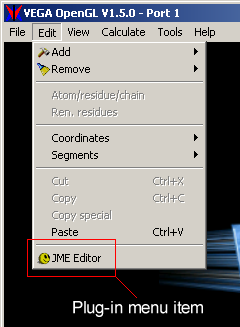| 2. Plug-in Software Development Kit (SDK) |
A
plug-in is a DLL (Dynamic Link Library), that it is automatically loaded when
VEGA starts. At the present time, the SDK is tested with Gcc (6)
and Borland C/C++ Builder (7), but it also works with other C compilers. This DLL must have three
exported functions - Init(), Free() and Call() -, whose
definitions, constants and macros are included in the plugin.h header
file.
The Init() function allows the initialization of the plug-in,
describing the plug-in data (type, name and release) and the menu items, that
will be added to the VEGA main menu.
The Free() function allows the
release of all resources, when the program has terminated. In this subroutine
one must include all code to free the resources, that are used by the plug-in.
Finally the Call() function is the core of the plug-in, as it defines the
code associated with a specific menu item.
 |

Plug-in integration in VEGA graphic user interface (GUI). |
When you select a plug-in menu item
or press a button in the plug-in window, VEGA calls the corresponding subroutine
passing the function code. Any plug-in can control all VEGA functions, read and
modify the atom list, add a new atom and remove an atom in the list. VEGA stores
the atom information in a memory list. Each atom has its own allocated memory
space and each atom structure has the pointer to the next atom. Each atom is
described by a series of values that include: atom name, atom number, residue
name, residue number, chain indicator, 3D coordinates, atomic radius, atomic
charge, atom type, connectivity matrix and bond order. A plug-in can allocate
the corresponding memory to add a new atom, updating the pointer to total atoms
and last atom; likewise a plug-in can free up memory to delete an atom from the
list. These essential operations can be performed on the atom list of a
molecule, of a trajectory and on the point lists of a surface, for which the
saved data include the 3D coordinates and an associated value (it can be the
point color or a point parameter, e.g. MEP, MLP, ILM, PSA, etc). These functions
along with the specific features of VEGA allow any calculations on molecular
structures to be carried out, analyzed, modified and managed. A plug-in can send
commands to VEGA via the communication port associated to the main window to
control the built-in functions. This is a two-way communication, as VEGA
interprets and executes these commands, returning the operation results to the
plug-in.
| 3.
An example: the Predator plug-in |